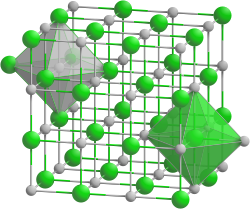Rubidium hydride
| Crystal structure | ||||||||||
|---|---|---|---|---|---|---|---|---|---|---|

|
||||||||||
| __ Rb + __ H - | ||||||||||
| Crystal system |
cubic |
|||||||||
| Space group |
Fm 3 m (No. 225) |
|||||||||
| Lattice parameters |
a = 604.9 pm |
|||||||||
| General | ||||||||||
| Surname | Rubidium hydride | |||||||||
| Ratio formula | RbH | |||||||||
| Brief description |
colorless prismatic needles |
|||||||||
| External identifiers / databases | ||||||||||
|
||||||||||
| properties | ||||||||||
| Molar mass | 86.48 g · mol -1 | |||||||||
| Physical state |
firmly |
|||||||||
| density |
2.65 g cm −3 |
|||||||||
| Melting point |
Decomposes at 300 ° C |
|||||||||
| solubility |
reacts with water |
|||||||||
| safety instructions | ||||||||||
|
||||||||||
| As far as possible and customary, SI units are used. Unless otherwise noted, the data given apply to standard conditions . | ||||||||||
Rubidium hydride is a chemical combination of rubidium and hydrogen .
Manufacturing
Rubidium hydride can be produced by reacting rubidium and hydrogen.
It is also created when heating with magnesium in a hydrogen stream.
properties
Physical Properties
Rubidium hydride crystallizes in the cubic crystal system in the space group Fm 3 m (space group no. 225) with the lattice parameters a = 604.9 pm, and 4 formula units per unit cell .
Chemical properties
When heated in a vacuum , rubidium hydride decomposes into the elements . The connection is extremely reactive.
Rubidium hydride reacts with water to form hydrogen gas.
The reaction with hydrogen chloride also releases hydrogen.
Rubidium formate is formed with carbon dioxide .
With sulfur dioxide formed during reaction under reduced pressure Rubidiumdithionit .
Rubidium hydride burns with elemental fluorine to form hydrogen fluoride and rubidium fluoride . The reaction mixture ignites even with elemental chlorine , but the reaction does not take place completely and a green mixed salt remains. Bromine and iodine react less violently.
With liquid ammonia , rubidium amide is formed with evolution of hydrogen ; at room temperature the reaction with gaseous ammonia takes place only very slowly.
Rubidium hydride reduces lead (II) oxide to elemental lead when heated , copper (II) oxide is reduced to elemental copper .
Individual evidence
- ↑ a b c d e f Jean D'Ans, Ellen Lax: Pocket book for chemists and physicists. 3. Elements, inorganic compounds and materials, minerals, Volume 3. 4. Edition, Springer, 1997, ISBN 978-3-540-60035-0 , p. 688 ( limited preview in the Google book search).
- ↑ David R. Lide (Ed.): CRC Handbook of Chemistry and Physics . 90th edition. CRC Press, 2009, ISBN 978-1-4200-9084-0 .
- ↑ This substance has either not yet been classified with regard to its hazardousness or a reliable and citable source has not yet been found.
- ↑ a b c d R. Abegg, F. Auerbach: Handbuch der inorganic Chemie. Verlag S. Hirzel, Vol. 2, 1908. P. 425. Full text
- ^ JW Mellor: "A comprehensive treatise on inorganic and theoretical chemistry", Volume 2, Verlag Wiley 1962, p. 2186. ( limited preview in the Google book search).
- ↑ a b c d H. Moissan: "Preparation et propriétés des hydrures de rubidium et de césium" in Compt. Rend. Hebd. 1903 , 136 , p. 587. Full text

![{\ displaystyle {\ ce {Rb2CO3 + Mg + H2 -> [\ Delta] 2RbH + MgO + CO2 ^}}}](https://wikimedia.org/api/rest_v1/media/math/render/svg/e55d639f7aaa2262062fce645eb127756fec797f)






